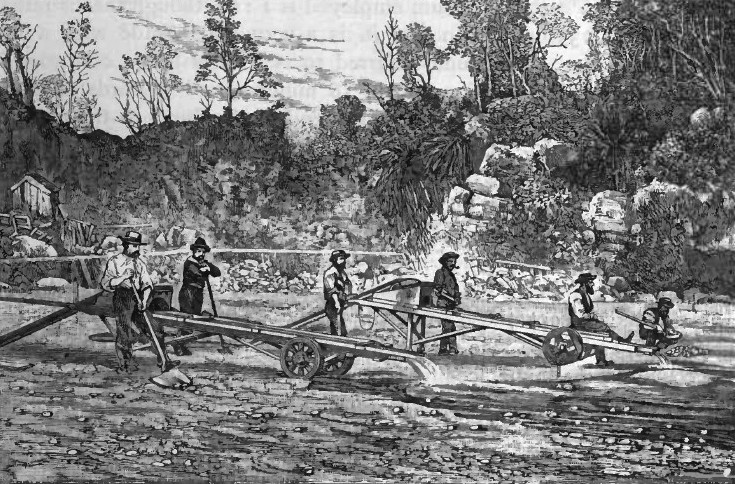On the Pacific shores of Canada and America, extending in patches for a considerable distance from southern California to Alaska and the Bering Sea, are a number of auriferous deposits, known as "ocean-placers." Similar formations exist also in New Zealand and elsewhere. The beach sands contain minute scales of gold and platinum, and a large percentage of magnetic iron or black sand, intermixed with the common beach sand, composed principally of quartz. The gold occurs in sufficient quantities to make mining for it remunerative at certain places. In beach-mining, considerable aid is derived from the natural causes at work the winds, tides, and surf, which act as a natural separator in parting the light and useless from the heavy and valuable particles. The force of the wind drives heavy swells upon the beach at high tide, and with them a certain amount of sandy matters; while at the ebb of the tide, the surf lashes the beach and carries back the light portions of the mass with the undertow, leaving some of the iron-sand, gold, and platinum, whose greater specific gravity enables them to resist the force.
At low water, the miners go down on the beach and scrape up the iron-sand, which is generally left in thin layers, stacking it back from the reach of the surf, and subsequently washing out the gold. The position of the sands is liable to be changed at every tide, so that a fresh survey has to be made each day before commencing operations. When the richest spot has been chosen, mules laden with empty containers are led down to it at low water, and the most specious-looking portions are hastily gathered for treatment at leisure, a couple of days often sufficing to wash the harvest of a month. For a long time, the common mode of washing was with a small stream of water in a sluice, terminating on an apron or torn, with turned up sides and ends, the bottom perforated with small holes, and underneath a wooden box set slightly sloping, and floored with a covering of amalgamated sheet copper. The auriferous sand is washed upon the apron, and, passing through the small holes, strikes vertically upon the copper below, the gold adhering to the copper, while the worthless sand passes off through an opening in the lower end of the box. This process is manifestly imperfect, as all the gold that does not instantly adhere to the copper is washed off and lost As the particles of magnetic oxide are very nearly of the average diameter of the gold-particles, and are moreover rounded, whereas the gold is scaly, the great difference in their specific gravity has really but little influence on their separation.
The ordinary blanket-sluice, or a combination of amalgamated copper plates, riffles, hanging-plates, &c., such as the Russel amalgamator, were for a long time relied on for catching the gold. But when the miners assayed their tailings, they found that in most cases fully 80% of the gold had been lost in the treatment. Not only was the separation based on a difference of specific gravity quite unavailing, but examination showed that the gold-specks were coated with "rust," which prevented amalgamation.
In New Zealand a considerable amount of "beach-combing" is carried on where water is available, and with most satisfactory results. At North Beach, a head race was carried 5 miles from the Maori river, and the washing yielded up to 1 oz. a day per man. At Seventeen-mile Beach, near Greymouth, are over 10 miles of auriferous seashore, with at least 4 lines of pay-dirt, and extensive operations are now being carried on. About 2 miles N. of Charleston is a settlement of Shetlanders, whose working time is divided between small farm cultivation and the working of fine gold from the sea-sands, which, after heavy weather, are easily got at and found to be highly auriferous. These beach-claims are deemed valuable property, and are kept carefully registered.
The working results of these claims is highly variable, and almost impossible to estimate, as the beaches being often sit unworkable for months, for it is only heavy seas and strong winds that form payable gold streaks upon them. It is roughly estimated that the average wages throughout the year would not be less than 2 pennyweights per week. Many of the " beach-combers "are of opinion that the gold on their claims comes from the depths of the sea during the storms, and not from the inland workings, as many others suppose. It is, however, a difficult question to determine.
Continue on to:
Beach
Mining: Part I, Shore Deposits
Beach Mining: Part II, Alaska and California
Beach Mining: Part III, Oregon
Beach Mining: Part IV, Nome, Alaska
Return To:
All About Placer Gold
Deposits


